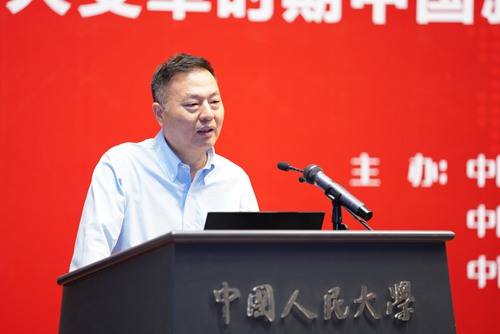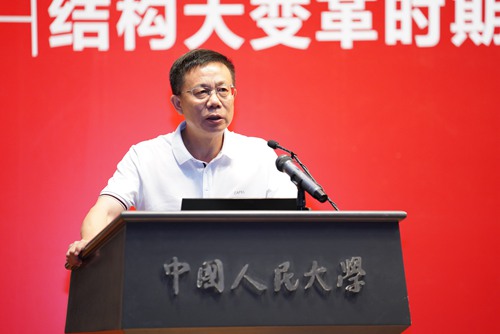 Research Update
Research Update
22
SepOn September 21, 2019, China Macroeconomic Forum (Q3 2019) was jointly hosted by National Academy of Development and Strategy (NADS), School of Economics, Renmin University of China (RUC) and China Chengxin International Credit Rating Co., Ltd. A report with the theme of “New Phenomenon, Rules and Trends: China’s Employment under Structural Changes” was released at the forum.
Liu Yuanchun, Vice President of RUC, Yang Ruilong, Dean at Institute of Economic Research, RUC, Zhang Chewei, Dean at Institute of Population and Labor Economics, Chinese Academy of Social Sciences, Huang Guitian, President and Deputy Party Secretary of ShanXi University, Yan Yan, Chairman of China Chengxin Credit Management Co., Ltd, Deputy Dean at Institute of Economic Research, RUC, Lai Desheng, Professor of National Academy of Governance, Ding Shouhai, Professor at School of Applied Economics, RUC, and over 200 people from the media, academia and business community attended the conference.

The first part of the forum was moderated by Yang Ruilong, Dean at The Institute of Economic Research, RUC. Professor Ding Shouhai presented the main report of New Phenomenon, Rules and Trends: China’s Employment under Structural Changes on behalf of the China Macroeconomic Forum research group.

According to the report, China’s employment situation has changed from stable development to ups and downs since the beginning of 2019, with surveyed unemployment rising to 5.3% twice before quickly falling back, risk factors flashed and disappeared. Thus, we should stay alert to current employment situation.
The report analyzed the employment problems in China from six dimensions: first, driven by multiple factors, unemployment in the industries of automotive, telecommunication, textile, real estate, and information service is prominent. Second, the unemployment situation in Northeastern China and Beijing-Tianjin-Hebei regions is the most severe compared with the rest part of China. Third, the private economy faces greater challenges with much slower employment growth and urgent needs. Fourth, small and micro businesses with sluggish performance can’t serve as the sponge to absorb the unemployed. Fifth, the start-ups went through a wave of bankruptcy result in a decline of self-employment. Besides, strict city management regulation caused a sharp decrease in the traditionally flexible employment especially when alternative employment patterns are still under test. Sixth, the employment pressure of college graduates broke the record this year. Young people aged from 20 to 29, particularly from 20 to 24, and those barely graduated from junior high school, felt the pain most.
In the future, China should be alert to the following five risks: the first and the biggest risk in the short run is the escalation of China-US trade tensions. At first, the US tariffs on Chinese goods are not concentrated on labor-intensive industries and with relatively small scale, thus having no obvious effects on our employment. Once the US focused fire on Chinese labor-intensive industries and hiked up the tariff continuously to a certain critical point, it won’t be impossible for some industries in certain regions of China to suddenly fall into bankruptcy.
Among the major categories of export industries, nine industries including general equipment manufacturing deserve more attention as they directly employed 70% of the total workers supporting Chinese exports to the United States. For them, a tariff rate slightly lower than 25% might trigger a wave of job loss. It’s possible that the general equipment manufacturing, electric machinery and apparatus manufacturing, metal products industry, and rubber and plastic products industry supporting nearly 5 million jobs have already reached the critical point of unemployment.
Regionally speaking, Chinese exports of general equipment to the US are mainly located in Wuxi, Changzhou from Jiangsu province, Qingdao, Linyi from Shandong province, Wenzhou, Ningbo from Zhejiang province. Exports of electric machinery located in Suzhou, Changzhou from Jiangsu, Jinan from Shandong, Foshan, Dongguan from Guangdong. Exports of metal products located in Jinhua from Zhejiang, Wuxi, Changzhou from Jiangsu, Foshan, Dongguan from Guangdong. Exports of rubber and plastic products located in Ningbo, Taizhou, Wenzhou from Zhejiang, Foshan, Dongguan from Guangdong. The local government and business communities in the above-mentioned cities should take preventive actions and get ready for the potential risks.
The second risk is the increasing loss of enterprises, in particular the weak small and medium-sized private enterprises, might cause waves of the closedown of factories, leaving the mass people unemployed in the labor market.
The third risk is the current problem in the industrial sector will infect the productive service industry because the latter is highly sensitive to industrial performance. Meanwhile, warehouse logistics, information transmission and other service industries created not only jobs but many high-quality positions, meaning both the quantity and quality of employment will be influenced.
The fourth risk is job loss because of technological innovation and development, a significant sign shown in the manufacturing sector.
The fifth risk is Chinese government under increasing fiscal pressure can only exert limited intervention on the employment issue, stuck in between budget deficit and job creation.
Based on the analysis, the report estimated that if the Chinese economy can maintain a growth rate at 6.2% in 2019, then non-agricultural jobs increase would just be 4 million, about 2.3million less than that of last year. Furthermore, if China could still keep growing at 6.2%, non-agricultural jobs would show recovery, but mainly driven by low productive traditional service sectors such as wholesale and retail, housing and catering, lease and business service. To some extent, the recovery will be made at the expense of employment quality.
The report concluded with several policy recommendations on how to achieve employment stability in the short term and high-quality employment in the long run.
First, for certain industries and regions attacked most seriously by the trade war, China should make targeted intervention policies or take guide measures, and make it quickly.
Second, for industries such as automotive and mobilephone under greater pressures, we should work out a specialized solution, not an isolated one but requiring comprehensive consideration of industrial policy, consumption, tax and traffic control policies.
Third, the government should attach more importance to the business difficulties of small and micro private enterprises, provide support and reduce the burden from multiple dimensions.
Fourth, relax tight control and restrictions on street vendors and nighttime economy properly, thus increasing the opportunities for flexible employment.
Fifth, the government should use subsidies and other tools to correct the market reaction to technological innovation and provide guidance and support for the young unemployed.
Sixth, the government should conduct positive fiscal policies such as special bonds to create more jobs while keep in mind the potential negative impacts brought by financing deficit.
Seventh, the future employment policy should focus on high-quality employment. Negative employment policies should be further improved by building a sound social safety network.

Yan Yan, Chairman of China Chengxin Credit Management Co., Ltd, Deputy Dean at Institute of Economic Research, RUC, moderated the next round of discussion.
Liu Yuanchun, Vice President of RUC

In the past 10 years, China has experienced both supply-side and demand-side turning changes of employment, thus to judge whether China is faced with overall unemployment or specific recruiting trouble or high labor costs should refer to how strong the coupling of the supply-side turning change and the demand-side turning change are. At present, various employment data are contradictory to each other, the correlation between different data is weak, and so do data and macroeconomic fluctuations, therefore, to study employment trend, it’s necessary to filter the noise caused by some incomplete employment indicators and focus on the depth of research. Although the current internal and external pressures on the Chinese economy are not still increasing, the overall employment outlook is more optimistic than expected. In the critical period of great power competition, the bottom line is to ensure the quantity and stability of national employment in comparison to the structural problems.
Zhang Chewei, Dean at Institute of Population and Labor Economics, Chinese Academy of Social Sciences

China’s overall employment is undergoing increasing demand but decreasing supply because of a slow but still growing economy, and a gradual reduction of the labor force. In the past, China’s employment in a dual economy has little to do with economic growth. However, with the arrival of the Lewis turning point, the future GDP growth will greatly affect employment. At present, the impact of economic growth is more in terms of labor costs than employment quantity. As the fourth industrial revolution approaches, the interpretation and laws of employment in neoclassical economics might fail so China’s employment problems should be explained from its own perspective. In the short run, the most noteworthy issue is the China-US trade tensions, in particular, its regional and structural risks to China’s employment even though right now its impact on employment is lower than expected.
Huang Guitian, President and Deputy Party Secretary of Shanxi University

Since the industrial revolution, the unemployment rate has been mostly affected by the long-term economic performance or cycling economic fluctuations, not so obviously by technological progress. In general, despite many studies, no absolute conclusion or consensus has been made that technological progress would make labor force replaceable on the large-scale. Technological progress is more likely to have a positive impact on employment instead of counterintuitively negative one judging from the experiences of several industrial revolutions in history. However, this new round of technological innovation might be different from past experiences, especially artificial intelligence, which may cause substantial changes in the ratio of labor to capital. So more attention should be paid to whether this technological progress will bring about large-scale, comprehensive and continuous replacement of labor, and establish a systematic monitoring system to keep a close eye on the impact of technological progress on employment.
Lai Desheng, Professor of National Academy of Governance

Despite all the changes, China’s overall employment situation is stable and controllable. Still, unemployment problems in certain regions and industries need attention. The current employment problem is more serious than that in 1997 and 2008 crises, and to deal with this complex issue, three priorities should be addressed. The first is to make comprehensive and specific policies in the promotion of stable employment. Secondly, higher education should improve its disciplinary structure. Finally, encouraging rural and agricultural development, thus more migrant workers and college graduates would return to their hometown for employment or entrepreneurship.